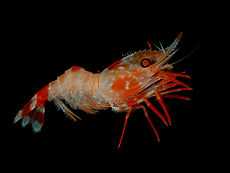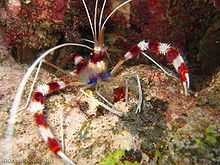Natantia
Natantia (Boas, 1880) is an obsolete taxon of decapod crustaceans, comprising those families that move predominantly by swimming – the shrimp (comprising Caridea and Procarididea), prawns (Dendrobranchiata) and boxer shrimp. The remaining Decapoda were placed in the Reptantia, and consisted of crabs, lobsters and other large animals that move chiefly by walking along the bottom.[1] The division between Natantia and Reptantia was replaced in 1963, when Martin Burkenroad erected the suborder Pleocyemata for those animals that brood their eggs on the pleopods, leaving Dendrobranchiata for the prawns.[1] Under this system, Natantia is a paraphyletic group. Burkenroad's primary division of Decapoda into Dendrobranchiata and Pleocyemata has since been corroborated by molecular analyses.[2]
Further reading
- S. De Grave & C. H. J. M. Fransen (2011). "Carideorum Catalogus: the Recent species of the dendrobranchiate, stenopodidean, procarididean and caridean shrimps (Crustacea: Decapoda)" (PDF). Zoologische Mededelingen 85 (9): 195–589, figs. 1–59. ISBN 978-90-6519-200-4.
References
- ↑ 1.0 1.1 Raymond T. Bauer (2004). Remarkable Shrimps: Adaptations and Natural History of the Carideans. Animal natural history series 7. University of Oklahoma Press. p. 206. ISBN 978-0-8061-3555-7.
- ↑ Alicia Toon, Maegan Finley, Jeffrey Staples & Keith A. Crandall (2009). "Decapod phylogenetics and molecular evolution". In Joel W. Martin. Decapod Crustacean Phylogenetics (PDF). CRC Press. pp. 9–24. ISBN 978-1-4200-9258-5.


